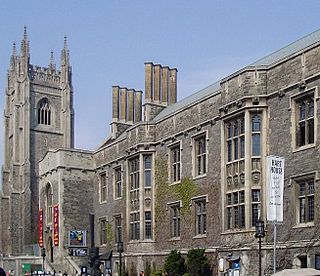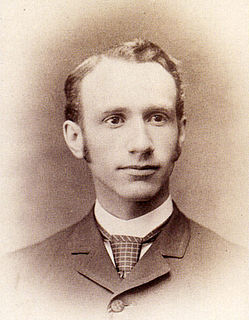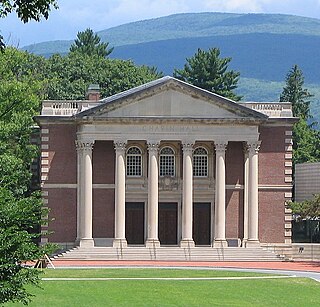
A church building or church house, often simply called a church, is a building used for Christian religious activities, particularly for Christian worship services. The term is often used by Christians to refer to the physical buildings where they worship, but it is sometimes used to refer to buildings of other religions. In traditional Christian architecture, the church is often arranged in the shape of a Christian cross. When viewed from plan view the longest part of a cross is represented by the aisle and the junction of the cross is located at the altar area.

Princeton University is a private Ivy League research university in Princeton, New Jersey. Founded in 1746 in Elizabeth as the College of New Jersey, Princeton is the fourth-oldest institution of higher education in the United States and one of the nine colonial colleges chartered before the American Revolution. The institution moved to Newark in 1747, then to the current site nine years later, and renamed itself Princeton University in 1896.

Ralph Adams Cram was a prolific and influential American architect of collegiate and ecclesiastical buildings, often in the Gothic Revival style. Cram & Ferguson and Cram, Goodhue & Ferguson are partnerships in which he worked. Together with an architect and artist, he is honored on December 16 as a feast day in the Episcopal Church of the United States. Cram was a fellow of the American Institute of Architects.

Gothic Revival is an architectural movement popular in the Western world that began in the late 1740s in England. Its popularity grew rapidly in the early 19th century, when increasingly serious and learned admirers of neo-Gothic styles sought to revive medieval Gothic architecture, in contrast to the neoclassical styles prevalent at the time. Gothic Revival draws features from the original Gothic style, including decorative patterns, finials, lancet windows, hood moulds and label stops.
Wolfpack or wolf pack may refer to:

Bertram Grosvenor Goodhue was an American architect celebrated for his work in Gothic Revival and Spanish Colonial Revival design. He also designed notable typefaces, including Cheltenham and Merrymount for the Merrymount Press. Later in life, Goodhue freed his architectural style with works like El Fureidis in Montecito, one of the three estates designed by Goodhue.

Collegiate Gothic is an architectural style subgenre of Gothic Revival architecture, popular in the late-19th and early-20th centuries for college and high school buildings in the United States and Canada, and to a certain extent Europe. A form of historicist architecture, it took its inspiration from English Tudor and Gothic buildings. It has returned in the 21st century in the form of prominent new buildings at schools and universities including Princeton and Yale.

Chestnut Hill is an affluent New England village located six miles (9.7 km) west of downtown Boston, Massachusetts, United States. Like all Massachusetts villages, Chestnut Hill is not an incorporated municipal entity. Unlike most Massachusetts villages, it encompasses parts of three separate municipalities, each located in a different county: the town of Brookline in Norfolk County; the city of Boston in Suffolk County, and the city of Newton in Middlesex County. Chestnut Hill's borders are roughly defined by the 02467 ZIP Code. Chestnut Hill is not a topographical designation; the name refers to several small hills that overlook the 135-acre Chestnut Hill Reservoir rather than one particular hill. Chestnut Hill is best known as the home of Boston College, part of the Boston Marathon route, as well as the Collegiate Gothic canvas of landscape architect Frederick Law Olmsted.
Charles Donagh Maginnis was an Irish architect. He emigrated to Boston at age 18, trained as an architect and went on to form the firm Maginnis & Walsh, designing ecclesiastical and campus buildings across America. From 1937 to 1939 Maginnis held the office of President of the American Institute of Architects.

James Gamble Rogers was an American architect. He is best known for his academic commissions at Yale University, Columbia University, Northwestern University, and elsewhere.

Hart House is a student activity centre at the University of Toronto. Established in 1919, it is one of the earliest North American student centres. Hart House was initiated and financed by Vincent Massey, an alumnus and benefactor of the university, and was named in honour of his grandfather, Hart Massey. The Collegiate Gothic-revival complex was the work of architect Henry Sproatt, who worked alongside decorator Alexander Scott Carter, and engineer Ernest Rolph, and subsequently designed the campanile at its southwestern corner, Soldiers' Tower.

Romanesque Revival is a style of building employed beginning in the mid-19th century inspired by the 11th- and 12th-century Romanesque architecture. Unlike the historic Romanesque style, however, Romanesque Revival buildings tended to feature more simplified arches and windows than their historic counterparts.

Gothic Revival architecture in Canada is an historically influential style, with many prominent examples. The Gothic Revival was imported to Canada from Britain and the United States in the early 19th century, and rose to become the most popular style for major projects throughout the late 19th and early 20th centuries.

In architecture, a quadrangle is a space or a courtyard, usually rectangular in plan, the sides of which are entirely or mainly occupied by parts of a large building. The word is probably most closely associated with college or university campus architecture, but quadrangles are also found in other buildings such as palaces. Most quadrangles are open-air, though a few have been roofed over, to provide additional space for social meeting areas or coffee shops for students.

English Gothic is an architectural style originating in France, before then flourishing in England from about 1180 until about 1520.
Page and Steele was an architecture partnership created in 1926 by Forsey Pemberton B. Page (1885-1970) and W. Harland Steele (1900-1996) in Toronto. It is now part of the IBI Group of architectural and engineering firms.

Dan Everett Waid (1864–1939) was a prominent 20th century architect operating primarily in Illinois and New York. As chief architect for the Metropolitan Life Insurance Company, he and his partner designed the Home Office Building at 11 Madison Avenue along with dozens of other commercial, religious, residential and academic structures. He was appointed architect for the Board of Foreign Missions of the Presbyterian Church. He was also President of the American Institute of Architects (1924–1926).
















